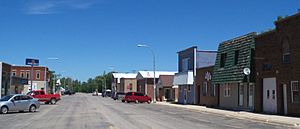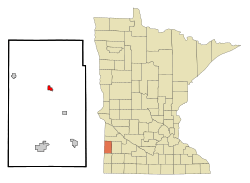Ivanhoe, Minnesota facts for kids
Quick facts for kids
Ivanhoe
|
|
|---|---|

Downtown Ivanhoe
|
|

Location of Ivanhoe
within Lincoln County, Minnesota |
|
| Country | United States |
| State | Minnesota |
| County | Lincoln |
| Area | |
| • Total | 0.67 sq mi (1.74 km2) |
| • Land | 0.65 sq mi (1.68 km2) |
| • Water | 0.02 sq mi (0.06 km2) |
| Elevation | 1,667 ft (508 m) |
| Population
(2020)
|
|
| • Total | 560 |
| • Density | 862.87/sq mi (333.25/km2) |
| Time zone | UTC-6 (Central (CST)) |
| • Summer (DST) | UTC-5 (CDT) |
| ZIP code |
56142
|
| Area code(s) | 507 |
| FIPS code | 27-31526 |
| GNIS feature ID | 2395446 |
| Website | https://city-ivanhoe-mn.com |
Ivanhoe is a small city located in Lincoln County, Minnesota, in the United States. In 2020, about 560 people lived there. Since 1902, Ivanhoe has been the main town, or county seat, of Lincoln County. It is currently the smallest county seat in Minnesota by population.
Contents
History of Ivanhoe
Ivanhoe was officially planned and laid out in 1901. It got its name from a famous novel called Ivanhoe by Sir Walter Scott. A post office started operating in Ivanhoe in 1901, helping people send and receive mail.
In 1902, Ivanhoe was chosen to be the county seat. This means it became the center for the county's government and official business.
Some notable people have connections to Ivanhoe. Richard Mulder, who was a doctor and a state legislator in Minnesota, lived in the city. Also, Gwen Walz, whose husband Tim Walz was a candidate for Vice President in 2024, grew up in Ivanhoe.
Geography and Location
Ivanhoe is a small city in terms of its size. According to the United States Census Bureau, the city covers about 0.67 square miles (1.74 square kilometers). Most of this area is land, with a small part being water.
The Yellow Medicine River flows near Ivanhoe. It is an intermittent stream, which means it doesn't always have water flowing in it, especially near its beginning.
Two important roads pass through Ivanhoe. These are U.S. Highway 75 and Minnesota State Highway 19. These highways help connect Ivanhoe to other towns and cities.
Population and People
| Historical population | |||
|---|---|---|---|
| Census | Pop. | %± | |
| 1910 | 484 | — | |
| 1920 | 655 | 35.3% | |
| 1930 | 556 | −15.1% | |
| 1940 | 606 | 9.0% | |
| 1950 | 682 | 12.5% | |
| 1960 | 719 | 5.4% | |
| 1970 | 738 | 2.6% | |
| 1980 | 761 | 3.1% | |
| 1990 | 751 | −1.3% | |
| 2000 | 679 | −9.6% | |
| 2010 | 559 | −17.7% | |
| 2020 | 560 | 0.2% | |
| U.S. Decennial Census | |||
Ivanhoe has a unique population for its area. A large number of its residents have Polish family backgrounds. This is not very common in other rural parts of southwestern Minnesota.
Ivanhoe's Population in 2010
In 2010, the city of Ivanhoe had 559 people living there. These people lived in 268 households, and 144 of these were families.
The city had about 635 people per square mile (245 people per square kilometer). There were 317 housing units, which are places where people can live.
Most of the people living in Ivanhoe in 2010 were White (99.8%). A very small number (0.2%) were from other racial backgrounds. About 0.4% of the population identified as Hispanic or Latino.
Households and Age Groups
Out of the 268 households in 2010:
- About 21.3% had children under 18 living with them.
- 44.0% were married couples living together.
- 7.1% had a female head of the household with no husband present.
- 2.6% had a male head of the household with no wife present.
- 46.3% were non-family households.
Many households (42.9%) were made up of just one person. About 23.2% of households had someone aged 65 or older living alone. The average household had about 2 people, and the average family had about 2.7 people.
The average age of people in Ivanhoe in 2010 was 49.5 years old.
- 18.8% of residents were under 18 years old.
- 5.3% were between 18 and 24 years old.
- 20.4% were between 25 and 44 years old.
- 27.1% were between 45 and 64 years old.
- 28.3% were 65 years or older.
In terms of gender, 44.9% of the population was male, and 55.1% was female.
See also
 In Spanish: Ivanhoe (Minnesota) para niños
In Spanish: Ivanhoe (Minnesota) para niños

